This post may contain affiliate links.
Summer is winding down, and Stef and I are wrapping up another great season of awesome RV trips and bike rides. Since we’ve been in the thick of a National Parks Tour, some of my favorite recent rides have happened in national parks around the country (some even on closed roads!). We’ve also taken a trip overseas, and rode the soggy but epic UCI World Championship Sportive in Yorkshire. And on top of all that cycling fun, there’s been our usual cycling gigs leading rides at GNR (and on the way to GNR, and on the way from GNR), and our annual pilgrimage to the Sea Otter Cycling Festival… best cycling event of the year.

Uh… Not me.
So as you can imagine after reading all of that… our bikes mean a lot to us. And we want to keep them.
Keeping them secure usually means locking them up while we’re RVing, so I’d like to share with you some of the strategies and techniques we use while we’re rolling in an RV.
First Off – This Post is for RVers.
I’m writing this specifically for RVers, and this has implications for bike locking. As RVers, we like to camp and get out in nature. If we’re in campgrounds, there are usually some other folks around. And we’re using the bikes primarily for recreation, and not for transportation. So, if you’re bike commuting to your job where you have to leave it all day in downtown New York City – maybe this isn’t the article for you.
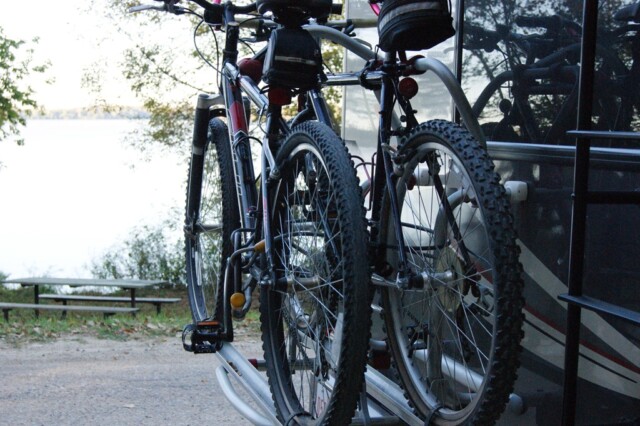
Our OLD mountain bikes on a Winnebago Fuse bike rack. We didn’t totally love these bikes… but they never got stolen!
We’re ONLY Talking About Theft Here…
The next point I want to make is that locking your bike is done to protect against theft of the bike. That’s ONLY theft, not spray paint or hacksaws. No amount of locking is going to protect your bike against a deliberate attempt to destroy it. And you can’t lock your bike to prevent petty vandalism – that’s impossible. Further, for the most part, locking won’t even necessarily prevent theft of bicycle seats, saddle bags, lights, etc. What you’re trying to prevent with a bike lock is coming back to find the whole bike just gone, so let’s keep that in mind as we think about locking bikes.
Bike Thieves are Lazy.
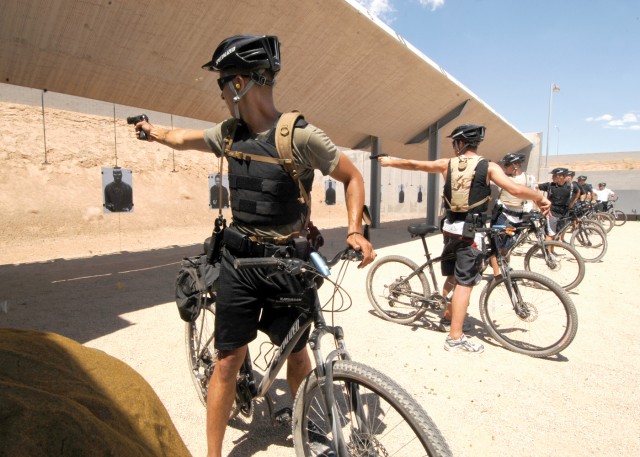
Your average bike thief is NOT a highly trained and well armed commando.
Let’s face it, if you’re a real go-getter, you probably didn’t pick “bike thief” for a career. (Even if they chose a career of crime, a genius and motivated thief has probably set their sights a little bit higher than stealing RVer’s bikes.) So it’s also helpful to remember that bike thieves are lazy, and probably not terribly bright.
Bike theft is usually a crime of opportunity. We’re trying to remove or limit the opportunities a bike thief will look for. The biggest opportunity you’ll remove with a lock is the ability to get away with the bike easily. If you can render your bike un-rideable, or even un-rollable with a lock, your typical opportunistic bike thief is going to look for an easier target.
And if you’re one of those people who feels compelled to add to any conversation about security “Locks just keep honest people honest,” or some other pithy aphorism that adds zero value, then re-read the above paragraph and save your keystrokes. Yes, given enough time/money/effort/dynamite any lock can eventually be defeated, we all know that. That doesn’t mean it’s not worth locking your bikes up.
It’s All About Context.
The next thing to think about is matching the level of protection to the situation (and to the bike). It should be obvious, but I’d apply different locking strategies to my very expensive time trial bike than I would apply to my beater bike from the 1980s. The same should apply to you. If you insist on indoor climate controlled storage for your bikes (guilty!) – they’re probably pretty valuable and require a like level of protection.
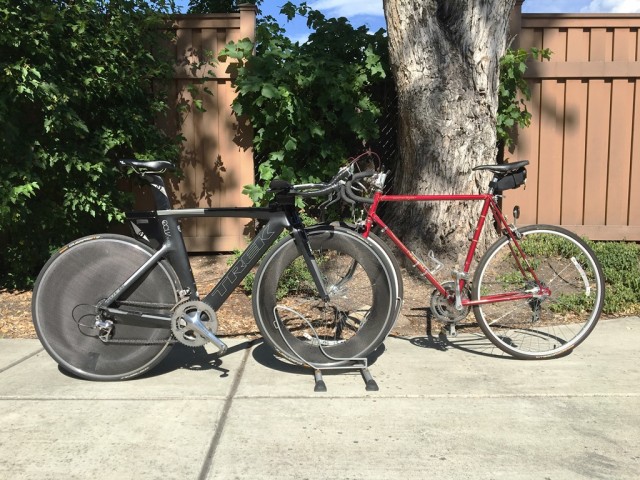
I’m going to try a little harder with one of these bikes; pretty sure you can figure out which.
The other part of context has to do with the location and the situation. No matter how much you like your bike, you don’t want to be the person rolling into the feed zone on your century ride carrying 10 pounds of chain and a massive lock. Some of the most secure bike locks are also the heaviest and most awkward. So if you’re talking about hanging out in a big field in Iowa with a bunch of other RVers (Hello GNR!), that requires a different level of security than street parking in a downtown busy urban area. Planning accordingly will ensure that you bring “enough”, without weighing yourself down with “too much.”
So with those ground rules out of the way, let’s start by looking at some of the different types of bike locks available. Then we’ll look at the situations that RVers with bikes are likely to find themselves in and see how we can apply those tools to those situations.
Bike Lock Types:
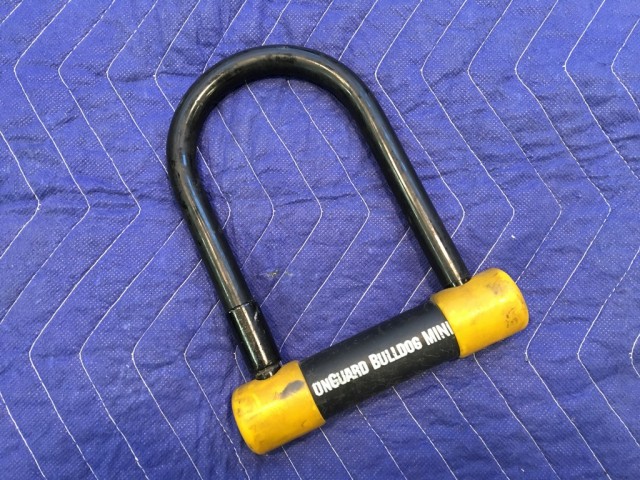
If you asked a hundred random people to draw a bike lock, most of them would give you a picture of a U-Lock. Pictured above is the U-lock that we travel with. It’s an older and smaller version of the OnGuard Bulldog U-Lock.
I think of a good U-lock as sort of the entry point into bicycle locking. If you get a good one, it can’t be defeated easily with bolt cutters (the preferred weapon of bike thieves). It’s not super easy to pick. And you’d have to spend a long time with a hacksaw to get through it.
A battery powered angle grinder might defeat it, but someone using an angle grinder at a campground is probably going to attract some attention. U-locks are susceptible to prying attacks (which is where you get a bottle jack or a crowbar into the empty space and use the leverage to pop the lock). If you’re buying a U-Lock, try to get the smallest one you can get away with. That reduces the opportunities for prying attacks, by making it harder to get a tool in there.
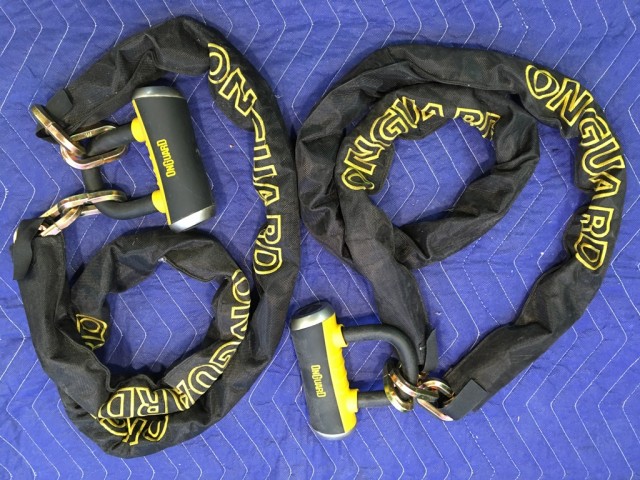
Next up is the chain lock. We travel with two of these, the OnGuard Mastiff.
Just the chain weighs about 10 pounds (seriously). They’re hardened steel – there’s no easy way to cut them with bolt cutters. And even a hacksaw or angle grinder is going to need a good bit of time to get through them. These are the locks Stef and I use on the outside of our RV when we lock bikes up to the back. It’s the highest level of bike security we RV with.
There are other styles of chain locks too, some with integrated locks and some without. Usually they are not quite as tough as the beast here, but they might have their place somewhere along the sliding scale of security.
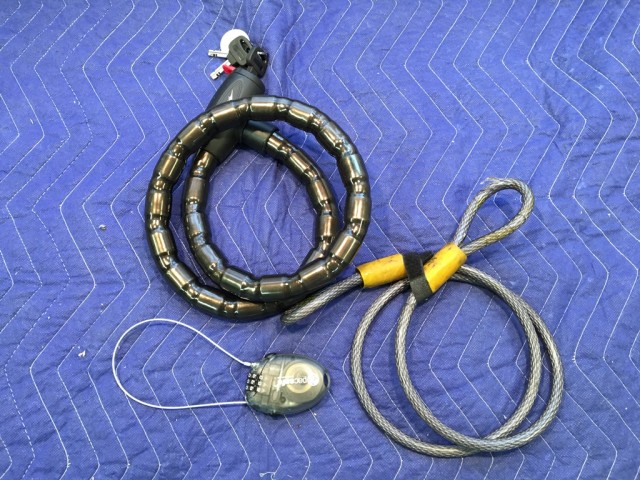
And finally, there are cables, cable locks, and other hybrid locks. These are the easiest to defeat – most of them can be defeated with just cable cutters or bolt cutters.
Personally, I don’t rely on these for primary security, but we do travel with two cable locks. We use an On Guard Cable (that I lock with our spare On Guard Mastiff lock). Though I am considering getting this cable lock from BOLT locks, because I can lock it with the same key I use to drive the vehicle. We also have a Pacsafe Retractasafe that I carry sometimes when I’m running bike errands. It’s terrible primary security for a bike, but it can be useful for things like locking your bike when you’re making a coffee stop. (In that case, I can usually still see the bike, and I just need to slow the thief down so I can catch them and make them rethink their lifestyle choices.) Rounding out that picture above is a variant of the Bell Ballistic 500 lock. I honestly don’t remember how I got it, or why. But I just looked and we have it with us in the van on this current trip. (Hello from New Mexico!)
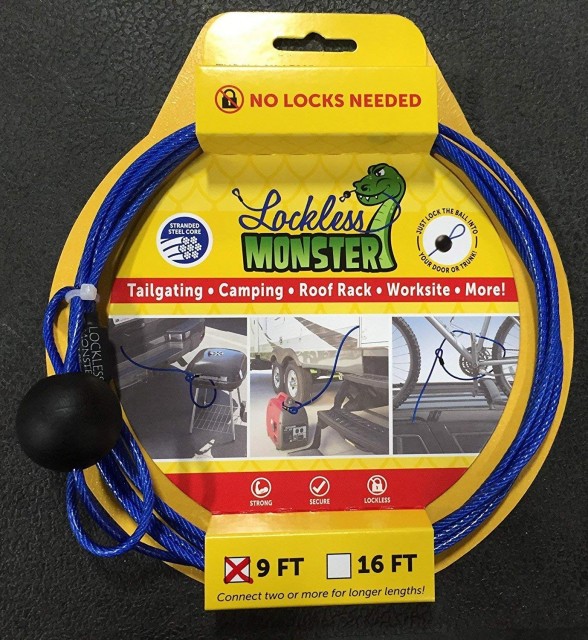
Another variant of the cable lock is the Lockless Monster. That cable needs a locking door to work, so it’s really useful when securing your bike to a vehicle. It’s not terribly secure though, but it might work if you were simply napping inside your rig.
Cable locks aren’t great, but they’re better than nothing.
They are useful as a way to augment your primary lock. They require a different attack than a U-lock, for example. And so by using two kinds of locks, you force a potential thief to carry two types of tools, which makes theft less likely. (Because remember, bike thieves are lazy, and lazy people don’t want to carry two tools.)
Other New Lock Developments:
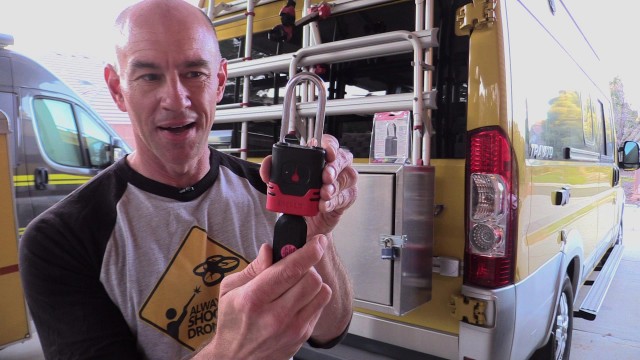
Another relatively recent twist on the cable and chain locks is the prospect of using a BOLT padlock on them. These padlocks use the same key that your vehicle does. Our ProMaster uses a center cut key that’s pretty difficult for your average idiot to pick. I haven’t decided if I am going to switch all our locks up to use the BOLT padlock, but the convenience is tempting.
There are lots of other takes on locks as people continue to think up new ways to lock up their bikes. Most of them are variants on the three kinds of locks we’ve already been over.
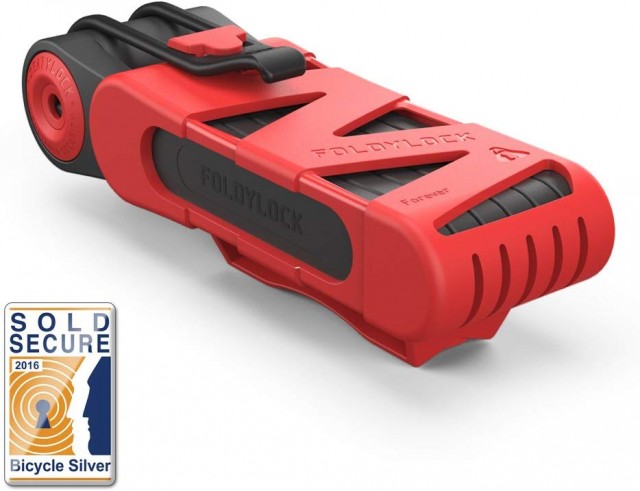
This Foldylock “Foldable” Lock, for example is just a bit of a cross between a cable and a chain.
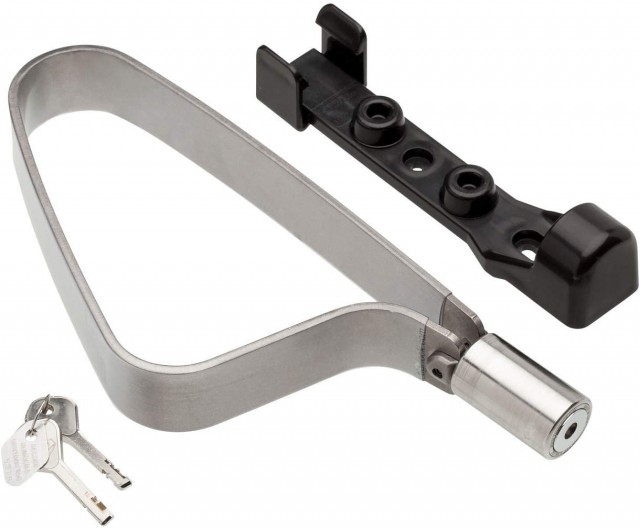
This TIGR Mini+ is a variation on a U-lock.
There are a number of interesting Frame Locks, that can keep your bike from being rolled away, (But some of them won’t stop the whole bike from being carried off.) And there are also “Smart Locks” that alarm if they are tampered with. We’ve been experimenting with the NuLock bike lock, but you can take your own pick. Most of these don’t strike me as terribly secure, but may work for you in some situations.
OK. So You’ve Got a Lock. Now what?
Now, about HOW to lock your bike. If you do any research online, you’ll come across the name Sheldon Brown. The late Sheldon Brown left a great repository of cycling knowledge. He proposed that basic bike locking can be done very simply.
According to Sheldon, all you need to do is to secure just your rear wheel to an immovable object through the rear triangle of the bike, like this:
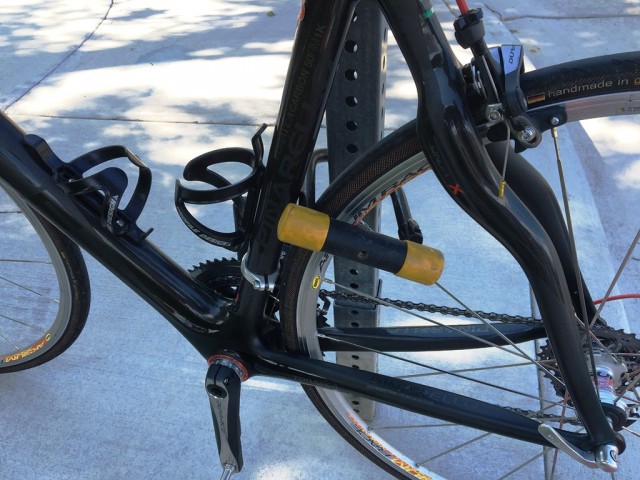
And that’s it!
Note that only the rear wheel is captured by the lock, which is also around the post. If you secure the bike that way, it can’t be rolled away or ridden, and the rear wheel can’t be removed from the frame. I admit it doesn’t seem from looking at it that this would be enough. But it really is. In theory, someone could hacksaw through the rear wheel and remove the lock. But then they’ve stolen an un-rideable bike, and they’ve destroyed the second most valuable part of it! So in everyday life, that rear-wheel hacksawing just doesn’t happen. (Remember – that whole bike thieves are lazy thing?)
And that is, in a nutshell the most basic way to lock your bike. Here are some other tips you can use to make this more effective:
Keep the lock as far as possible from the ground.
Why do this? Well, if you think about the ways thieves attack bike locks, it makes all of them more difficult. They won’t be able to use a hammer to smash bits against the concrete. They won’t be able to use the ground to lever their bolt cutters. And they’ll eventually get tired of trying to grind or saw something up at shoulder height. So keep those locks and chains off the ground.
Keep the extra cable or chain to a minimum.
Extra material just gives a potential thief something to work with, or a way to get part of it down to the ground, or away from the bike. Do yourself a favor, and take up all the slack you can in your locking system. In the picture below, I’ve wrapped the chain around the pole an extra time to take up slack.
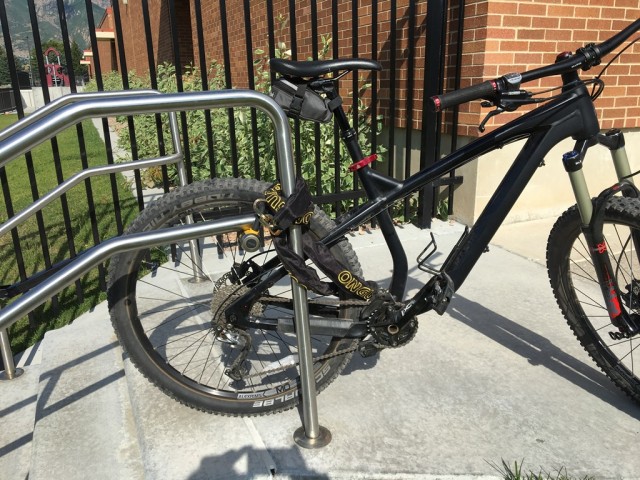
Just takes an extra two seconds to take up the slack.
You can augment the basic locking strategy even further:
Secure the lock to the seat tube (or another part of the frame) instead of just the rear wheel.
This has the benefit of making it “look” more locked, so thieves might be more likely to pass on to another bike. The disadvantage is that it usually requires a bigger U-lock. Bigger U-locks are easier to get tools inside of. So they are more susceptible to prying and leverage attacks. The bigger the lock, the bigger the pry bar or jack you can wedge into it. We don’t carry a large U-lock, so I don’t use this method myself.
Secure the front wheel, too.
Again, this “looks” more secure. You can either remove the front wheel and lock it up alongside the back one, or you can run a secondary lock, cable, or chain through the front wheel as well. The disadvantage of this method is that it requires you to carry something extra with you. Some front wheels can be pretty valuable, but many aren’t. So think about that when deciding on how you want to secure your bike.
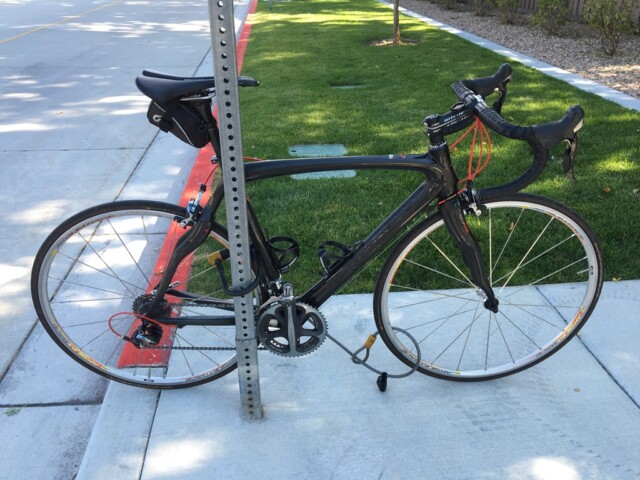
In this picture I’ve combined some of the above tips. There’s a U-lock, securing the rear wheel to a metal signpost. There’s also a chain looped around the front wheel and incorporated into the lock.
I’m Out In My RV. What do I do?
So now let’s go through some of the situations RVers are likely to encounter, and I’ll go over how I would lock up my bike in those situations. The first of those, is on your own bike rack.
Locking for Travel
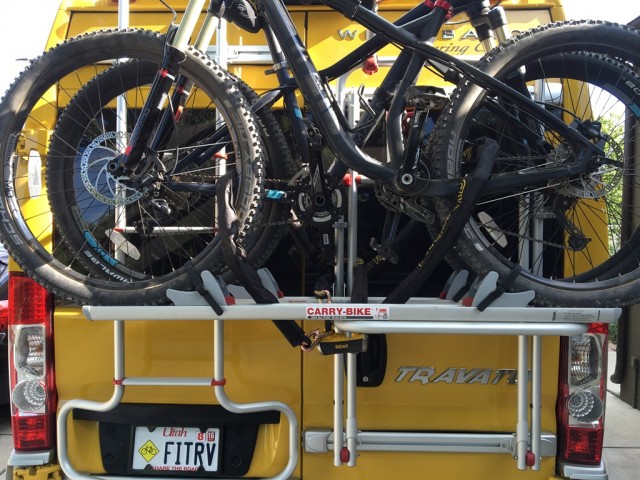
Many RVers travel with bikes on racks. In my opinion, this is the place where I need the highest level of security. Why? Because this is the location where I’m likely to leave my bikes on a city street while I’m inside a restaurant for two hours and can’t see it. This is where the bikes will be while I’m out hiking in the middle of nowhere for four hours. Accordingly, I pull out the highest level of security here.
First off – higher is better, as we’ve established, so I’m happy that our bike rack is pretty high up. I use two of my OnGuard Mastiff chains, which is the strongest deterrent I have. I secure the bikes through the rear wheels, inside the rear triangle, as per Sheldon. I then wrap the chain around the bike rack (which is secured to the RV). I also try to take up any slack in the chain, which makes an attack on the chain more difficult. Additionally, when I secure the lock, I secure the shackle around part of the bike rack, which makes it almost impossible to get any kind of prying implement inside it.
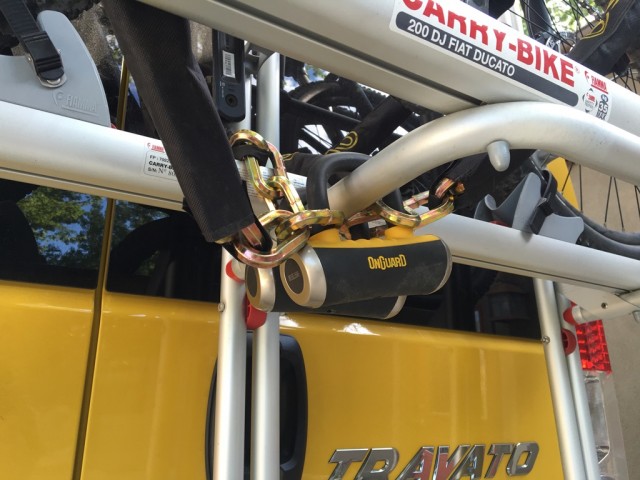
Now – VERY IMPORTANT. If you have rear doors on your RV like our Winnebago Travato here, DO NOT secure your bike or chain to both doors. This will make it impossible to open the doors! And that could be a real hazard in an emergency.
If I have only one bike to lock in this situation, I’ll just use one lock. If I have two bikes to secure I’ll set them nose to tail, and use two locks as you see above. This has the benefit of securing the front wheels on each bike as well. With 20 pounds of deterrent, I’m pretty confident about leaving the bikes outside on the rack in most circumstances. Ironically, it would be easiest for a thief to cut the bike rack itself and throw all of it into a truck. (But there’s not a lot I can do about that…)
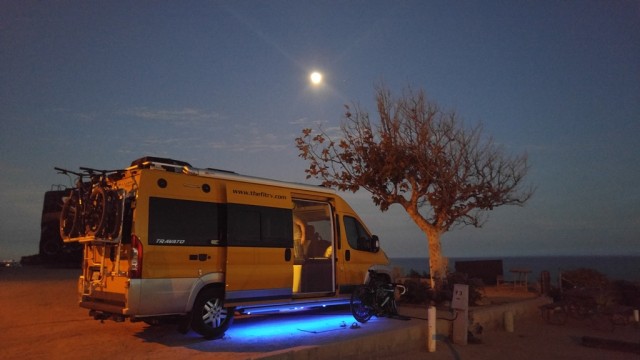
There are four bikes in this shot – and all of them are locked.
Locking in Camp
So that’s locking for travel. How about in camp? At a campsite, I feel like I can get away with a little less security. We’re usually nearby. Other people are usually around. And someone running an angle grinder at the Grand Canyon is certainly going to get noticed. Even so, security is still important, so I follow these guidelines.
First – look for a non-removeable object to lock your bikes to. You don’t want something that can be pulled out of the ground, chopped off like a sapling, or stolen and tossed into a pickup bed along with your bike. Fence posts work well here. But not the links of a chain link fence. Sign posts also work well, if they’re near your campsite and you’re legally permitted to lock to them. Picnic tables may or may not work, depending on their construction, and I usually avoid them.
If you can’t find a suitable pole, you can always leave your bike locked on the rack, assuming you have one. If that doesn’t work for some reason, the trailer hitch is one of my favorites.
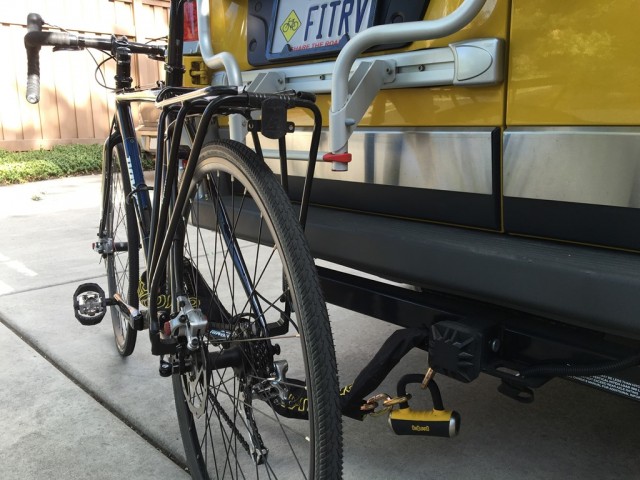
The trailer hitch is always there. Just about every RV has one. They’re typically rated for some pretty serious loads, which is good. And at night, if someone tries to cut through some part of it, it’s likely going to wake you up. I could have done a little better here by putting the shackle of the lock through the hitch. I’ll do better next time.
The main caveat with using the trailer hitch to lock your bikes is DON’T FORGET ABOUT IT AND DRIVE OFF! 🙂
Locking While Out and About
When you’re out and about with the bike, you’re usually riding it. Which means that some of the heavier-duty options like the On-Guard chains aren’t going to work (because you probably don’t want to carry them). What to do here?
Well, the best option is to not lock your bike at all! I always try to leave mine in the care of my awesome riding partner (Hi Stef!) while I step inside to use the restroom or to buy coffees.
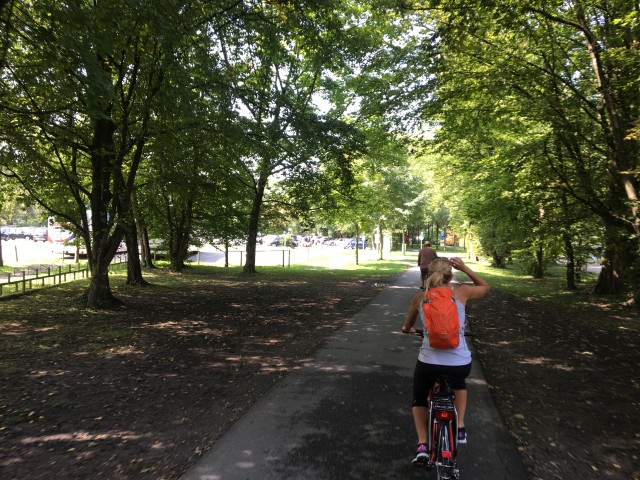
This is actually from a ride in Switzerland! But these rentals came with no locks, so we just had to take turns watching them.
But if you don’t have a Stef (or are just riding without her that day), there are still options. The coffee shop scenario is someplace I would use my PacSafe lock because it’s easy to use and better than nothing. I don’t trust it for long, but if I’m in line at a food truck, I’m good with it.
The “smart locks” are usually pretty light and made for this kind of scenario as well. But usually I don’t want to carry one of those on my longer rides. If you were riding to get groceries though, that could be a solid option.
The same general rules about finding something suitable to lock to apply out and about as they do at the campsite. Sturdy bike racks are becoming more common these days, so usually you can find something.
Nothing to Lock To?
Let’s say you’re in a “last resort” type situation. You need to lock your bike, but there’s no bike rack, no pole, no tree. Nothing. What do I do in these situations?
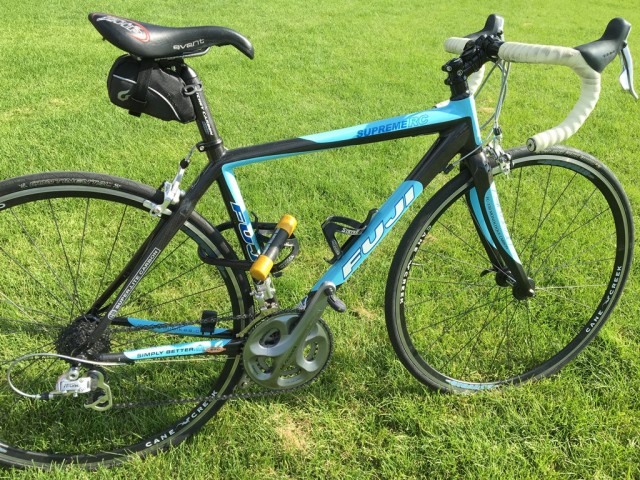
This bike isn’t rolling anywhere.
Well, the first thing to remember is that, if you follow the Sheldon Brown method and lock your rear wheel through the rear triangle, the bike is STILL UN-RIDEABLE AND UN-ROLLABLE even if it’s not locked to anything. It’s not great, but it’s better than nothing. Secure your U-lock, Chain, or cable lock to your bike as if you had a pole to lock it to. At the very least, nobody is rolling your bike away. They’re going to have to carry it or throw it in a truck.
If you have two bikes, you’re in better luck. In this situation, I secure the bikes to each other, nose to tail, using the same rear-triangle locking method. Again, nobody’s rolling them away. And even if they wanted to toss them into a pickup truck, it’s going to be an awful mess to try to pick up, let alone carry.
Today’s Scenario
So how do I put all this together in a real-world scenario? Take this afternoon for example. Stef and I are staying in a campground that seems safe(ish). But it’s not in the best part of town, and we’re thinking of heading a couple miles away for a coffee later. The Google satellite map shows that this coffee shop has no exterior seating, so we’ll likely be just leaving the bikes outside. We’ll be taking the mountain bikes.
If we were going to be on the ultra-light road bikes, we would probably just send one of us in to get the coffees and enjoy them elsewhere. The PacSafe lock would be another option, but its security is a bit lacking for my sense of the situation. Fortunately we’re taking the mountain bikes, so bringing a bit of extra weight isn’t such a hardship. (And I’ll be honest, we just don’t love our mountain bikes the same way we love our road bikes.) After putting all that into my brain, this is what it spit out:
I’m going to carry a cable lock, in this case, the old Bell Ballistic 500. It’s a bit more secure than a “regular” cable, and I can get it to wrap around the mountain bike’s seatpost so it doesn’t pull my jersey off while I ride.
So there you have it. That’s how we think about locking our bikes up while we RV. I’m always looking at new products and re-evaluating my thinking, so I’m interested in anything I don’t have on this list yet. Sound off in the comments below!











When I was a student in Eugene, OR, I had to bike every day to campus. I had a beater for that use, but it didn’t matter, anything got removed if it was removable. Front wheels, seat posts etc. The bike had fenders (remember what happens in the winter there?), so it was a little clunky to lock up easily. What I ended up doing was to use a normal Master key lock to lock the rear quick release lever to the frame and use a U-lock to lock the frame and front wheel to a steel fence (that was bolted to a brick building that was very heavy.) Worked fine for all the time I was there.
So I have the same bike rack. Now if I was a bike thief I could (A) try to defeat the lock or (B) cut through the hollow aluminum bike rack. For me, the best place to put the bike when I am away from the RV/Bike is *IN* the RV. Yeah, it’s a pain, but it’s cheaper and more secure.
We do store our road bikes inside. It’s only the mountain bikes that get the outside treatment. (They have a rougher life…)
Doh!
Just lock the rear wheel to something and of course it’s through the frame by default. So obvious why did I not think of it?
On the RV I have an ISI http://www.isi-carriers.com/ and one simple step is to use Allen bolts so you need an Allen key to remove the bikes (as you said theft is opportunist – they don’t normally carry Allen keys) which is what I use in camp grounds and then a chain if in town as well.
Allen keys are a good idea. Torx bolts are another.
Keep rolling!
The Dutch company AXA and German Abus have been making frame locks for years. These are great when you’re out and about because they completely immobilize the rear wheel if you run in for coffee.
For more permanent locking, some of them have a plug-in cable or chain. This lets you lock to the RV, a tree, or almost anything else. If you mount the lock on the lower side of the seatstays, and use a plug-in cable, the wheel cannot be removed from the rear triangle.
My favorite versions have “captive keys,” meaning that you can only remove the key when it’s locked. If you have the key in your hand, the bike is secure!
These aren’t for racing bikes but they are a lot lighter than U-locks. Only recently have they been available in the US. Search “AXA Defender” or “Abus Amparo” and a lot of results will come up.
I assume the U-lock has improved since the “ease of picking with a fountain pen” story aired on 60 Minutes several years ago?
I think that was back in 2004.
Kryptonite was the brand, and I believe they have long since fixed the issue.
We use a similar setup for securing the bikes when they’re on the rack but worry about the weight on the chain damaging the wheels or frame while we’re driving down the road so use a cable while driving and put the chain on when we stop. Spend a lot of time dragging the chain out and locking up the bikes at every rest or grocery stop along the way but so far we’ve managed to keep the bikes away from thieves.
Now that’s dedication!
Does your chain have a fabric or plastic “wrap” like ours do? I might worry about scratching, but the weight of the chain doesn’t concern me.
… of course, I don’t have my fancy carbon wheels on the rack either… Then I’d think twice about our heavy chain.
Great information James! Thanks for this post. We have the same Fiamma rack you do on Lance. Love it but haven’t found a good way to cover them while on trips. As a result we’ve gotten a good bit of rust and most recently had my wife’s bike headset completely froze up. Bike shop said the grease was gone! This on a one year old Specialized. Theorized the 70mph wind blast and elements up there may have done it. My question (finally!) Do you know of a way to cover your bikes up there on that Fiamma rack?
I’ve had several ideas over the years, but haven’t ever put any of them into action.
I know Fiamma makes some sort of bag/cover thing. If you troll the Fiamma European sites, you might see one you could order. I’ve never tried it though.
My most persistent idea is to get a big tarp, and cut a hole in it for the rack mounting, and then sew a bunch of Velcro onto it. It wouldn’t be pretty though.
I suppose this is why we’ve just settled on putting the bikes we love less back there, and continuing to ride with our favorite children inside (or in a trailer).
It’s hard to supplement this article. But here are two suggestions.
A vehicle security system can be fitted with an auxiliary cable that can secure other devices like trailers or bikes. Breaking the loop sets off the alarm and mine sends notification to my cell phone. That’s a lot of protection for a piece of wire.
HipLock makes a nice security tie that locks saddlebags or baskets to the bike which would otherwise be easily removable.
OK. The vehicle security system cable thing sounds completely awesome.
Do you have a link?